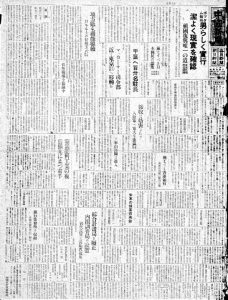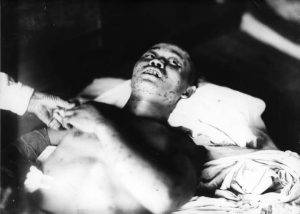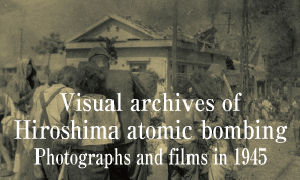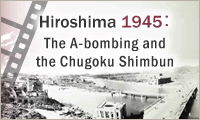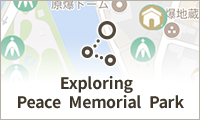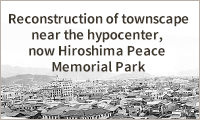Documenting Hiroshima of 1945: September 3, Chugoku Shimbun resumes printing of newspaper on its own, calls for relief and aid
Sep. 3, 2024
by Kyosuke Mizukawa, Senior Staff Writer
On September 3, 1945, the Chugoku Shimbun was able to print the newspaper on its own for the first time since the atomic bombing. With great damage to its head office in the central area of Hiroshima City and to its employees, the newspaper halted printing and, since August 9, had requested other newspaper companies to print the paper on its behalf. One rotary printing press that had previously been relocated to the village of Nukushina, Hiroshima Prefecture (in Hiroshima’s present-day Higashi Ward) was put into operation amidst power-supply issues after a trial-and-error process.
The front page of the newspaper published on September 3 carried an editorial titled “Request to national government regarding war devastation.” The article appealed to the government about how, “The tragedy in Hiroshima City truly defies description … We do hope that proactive and concrete relief measures can be carried out by the national government as soon as possible.”
As the number of deaths continued to rise even after Japan’s surrender in the war, the editorial praised the efforts to investigate the city’s devastation by a survey team headed by Masao Tsuzuki, a professor at Tokyo Imperial University (present-day University of Tokyo). “We appreciate their conscientious enthusiasm,” read the editorial. Articles carried in the Chugoku Shimbun published on September 4 and 5th reported in detail on the measures to treat A-bomb disease put forth by Mr. Tsuzuki, among other topics.
On September 3, about 20 U.S. war correspondents from the New York Times and other media organizations arrived in Hiroshima. They met with a prefectural police manager and local journalists covering prefectural politics at the Hiroshima Prefectural government offices, which were temporarily located at Toyo Kogyo (present-day Mazda Motor Corporation) in the town of Fuchu-cho, Hiroshima Prefecture. The local reporters asked their U.S. counterparts, “How did you feel when you saw the tragic situation in Hiroshima City?” The response was that the war correspondents had served on various fronts in Europe and the Pacific and felt Hiroshima had suffered the most damage of any city they had seen, as reported in the Chugoku Shimbun published on September 5, 1945.
Ichiro Osako, 32 at the time, a Chugoku Shimbun staff writer present at the meeting who died in 1995 at the age of 83, noticed a difference in equipment between the Japanese and American reporters. In the publication titled Hiroshima Showa 20-nen (in English, ‘Hiroshima 1945’), he wrote, “In contrast to their fine clothes, cameras, and motion film camera Eyemo, we wore beat-up civilian national uniforms, traditional split-toe work footwear, and leg gaiters. None of us had a camera.”
The international media also expressed great interest in the A-bombed Hiroshima. For their part, local journalists continued their work of reporting from the perspective of the A-bombed city, despite their difficult situation.
(Originally published on September 3, 2024)
On September 3, 1945, the Chugoku Shimbun was able to print the newspaper on its own for the first time since the atomic bombing. With great damage to its head office in the central area of Hiroshima City and to its employees, the newspaper halted printing and, since August 9, had requested other newspaper companies to print the paper on its behalf. One rotary printing press that had previously been relocated to the village of Nukushina, Hiroshima Prefecture (in Hiroshima’s present-day Higashi Ward) was put into operation amidst power-supply issues after a trial-and-error process.
The front page of the newspaper published on September 3 carried an editorial titled “Request to national government regarding war devastation.” The article appealed to the government about how, “The tragedy in Hiroshima City truly defies description … We do hope that proactive and concrete relief measures can be carried out by the national government as soon as possible.”
As the number of deaths continued to rise even after Japan’s surrender in the war, the editorial praised the efforts to investigate the city’s devastation by a survey team headed by Masao Tsuzuki, a professor at Tokyo Imperial University (present-day University of Tokyo). “We appreciate their conscientious enthusiasm,” read the editorial. Articles carried in the Chugoku Shimbun published on September 4 and 5th reported in detail on the measures to treat A-bomb disease put forth by Mr. Tsuzuki, among other topics.
On September 3, about 20 U.S. war correspondents from the New York Times and other media organizations arrived in Hiroshima. They met with a prefectural police manager and local journalists covering prefectural politics at the Hiroshima Prefectural government offices, which were temporarily located at Toyo Kogyo (present-day Mazda Motor Corporation) in the town of Fuchu-cho, Hiroshima Prefecture. The local reporters asked their U.S. counterparts, “How did you feel when you saw the tragic situation in Hiroshima City?” The response was that the war correspondents had served on various fronts in Europe and the Pacific and felt Hiroshima had suffered the most damage of any city they had seen, as reported in the Chugoku Shimbun published on September 5, 1945.
Ichiro Osako, 32 at the time, a Chugoku Shimbun staff writer present at the meeting who died in 1995 at the age of 83, noticed a difference in equipment between the Japanese and American reporters. In the publication titled Hiroshima Showa 20-nen (in English, ‘Hiroshima 1945’), he wrote, “In contrast to their fine clothes, cameras, and motion film camera Eyemo, we wore beat-up civilian national uniforms, traditional split-toe work footwear, and leg gaiters. None of us had a camera.”
The international media also expressed great interest in the A-bombed Hiroshima. For their part, local journalists continued their work of reporting from the perspective of the A-bombed city, despite their difficult situation.
(Originally published on September 3, 2024)

